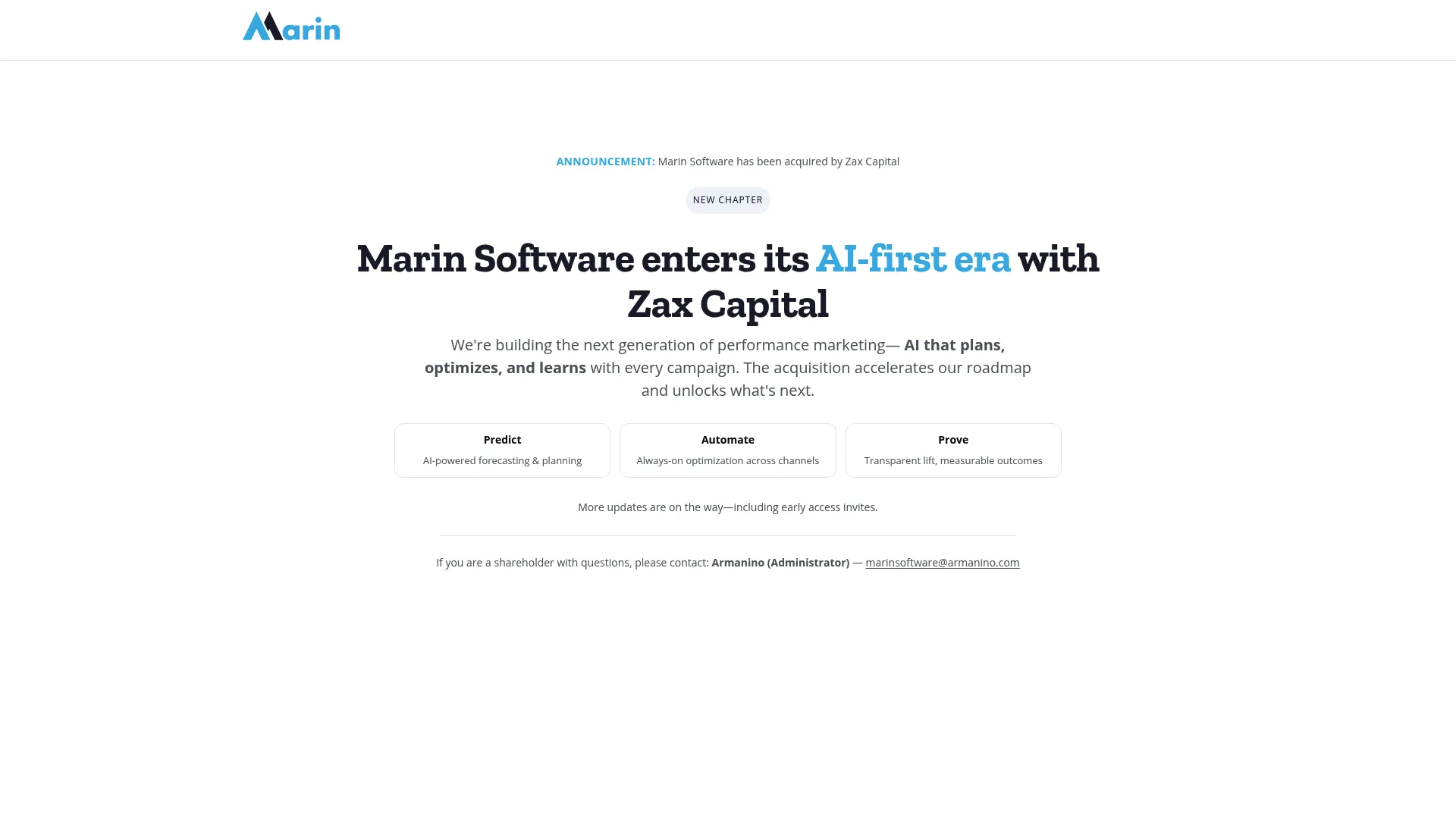
Marin Software Review: The Truth About Cross-Channel PPC Management in 2024
Look, I’ll be honest – I’ve been knee-deep in PPC platforms for the better part of a year, and let me tell you, most of them promise the moon and deliver… well, not the moon. Marin Software keeps popping up in conversations about cross-channel automation and transparent bidding, but does it actually live up to the hype? After digging into this thing and talking to actual users, I’m sharing everything you need to know about what it’s really like to use this platform day-to-day, including the stuff they probably won’t tell you in the sales demo.
Table of Contents
-
TL;DR: Key Takeaways
-
What is Marin Software?
-
Alternatives to Marin Software
-
Frequently Asked Questions
-
Final Thoughts
TL;DR: Key Takeaways
-
Marin Software nails the cross-channel integration and transparency thing, but the interface will make you question your life choices
-
People are saving 15+ hours weekly through automation, but expect to spend a lot of time just figuring out where everything is first
-
Five hundred bucks a month to start – ouch, right? That’s not exactly pocket change for most of us
-
The platform’s biggest headache is the “clunky” and “overwhelming” interface, especially after the MarinOne transition disaster
-
Customer support is like playing roulette – you might get someone amazing, or you might want to throw your laptop out the window
-
If you’re managing complex, multi-market campaigns and have the patience of a saint, the reporting capabilities are actually pretty solid
Criteria Table: Marin Software Evaluation
|
Criteria |
Rating |
Details |
|---|---|---|
|
Cross-Channel Integration |
4/5 |
Actually connects Google, Facebook, Amazon, TikTok, and 20+ platforms without breaking |
|
AI-Powered Automation |
4/5 |
The robots are helpful here – automated bidding that doesn’t completely lose its mind |
|
Transparency and Control |
5/5 |
Shows you exactly why it’s bidding what it’s bidding – refreshingly honest |
|
Ease of Use |
2/5 |
Like trying to navigate a spaceship when you just wanted to drive to the grocery store |
|
Support Quality |
3/5 |
Some people get PPC wizards, others get… well, let’s just say experiences vary |
|
Pricing Value |
3/5 |
$500/month starting price – you get what you pay for, maybe |
|
Reporting Capabilities |
4/5 |
Reports that don’t suck and actually tell you useful stuff |
|
Scalability |
4/5 |
Built like a pickup truck – can handle whatever complex campaigns you throw at it |
What is Marin Software?
What Marin Software is Best Known For
So here’s the thing about Marin Software – they’ve basically made their name by being the “honest” PPC platform. While most automated bidding tools are like those mystery boxes you see on social media (you have no clue what’s inside), Marin actually shows you what’s happening under the hood. It’s refreshing, honestly.
I’ve been managing campaigns across Google, Facebook, Amazon, and TikTok, and let me tell you – juggling all those platforms separately is like trying to cook a five-course meal while blindfolded. Marin’s promise of doing it all from one place? That got my attention real quick.
The transparency thing is legit their superpower. Most platforms basically say “trust us, our AI knows best” and leave you wondering why your bids went haywire last Tuesday. Marin shows you exactly why they adjusted that keyword bid – down to the penny. It’s like having a mechanic who actually explains what’s wrong with your car instead of just saying “engine stuff.”
And those time savings everyone talks about? Yeah, they’re real. I was spending my Sunday mornings pulling reports from five different platforms like some kind of digital marketing masochist. Now I get 15+ hours back each week. That’s a whole Netflix series worth of time!

Core Features and Capabilities
Okay, so what does this thing actually do? Think of it as your PPC Swiss Army knife – it’s got AI-powered optimization, multi-channel attribution tracking, analytics that don’t make your eyes bleed, automated budget management, custom reporting, bid management with impression share targeting, and CRM integration. Basically, all the stuff you wish you had time to do manually but absolutely don’t.
The AI isn’t just your basic “set it and forget it” automation either. This thing actually learns from your campaigns, figures out when people are most likely to convert, and adjusts accordingly. It’s like having a really smart intern who never sleeps and doesn’t drink all your office coffee.
Here’s where it gets interesting – the multi-channel attribution actually works. You know how you’ve always wondered if that Facebook ad really helped drive those Google conversions? Marin connects those dots. It’s not perfect (nothing is), but it’s way better than the guessing game most of us have been playing.
The reporting features let you slice and dice data however your boss wants to see it this week. Custom dimensions, company-specific values, all that good stuff that makes you look like you really have your act together in those Monday morning meetings.
Pros: What People Actually Love About This Thing
You Can Actually See What’s Happening
Remember when I mentioned the transparency thing? This is huge. Instead of wondering why your automated bids went crazy, you can see exactly what triggered each change. It’s like having X-ray vision for your PPC campaigns.
Getting Your Life Back
Those 15+ hours I mentioned? That’s not marketing fluff – that’s real time you get back. One guy I know used to spend his entire Friday afternoon compiling reports. Now he’s done by lunch and actually has a social life again.
Everything in One Place (Finally!)
No more browser tabs that look like a digital hoarder’s paradise. Google, Facebook, Amazon, TikTok – it’s all right there. Your sanity will thank you.
It Handles the Complex Stuff
If you’re running campaigns across 22 different markets (bless your heart), this platform won’t break a sweat. It’s built for the kind of complexity that makes normal people cry.
Actual Human Support (Sometimes)
When you’re spending the big bucks, you get real people who know what they’re talking about. It’s like having a PPC therapist on speed dial.
Cons: Where This Thing Will Drive You Nuts
The Interface is… Challenging
Look, I’m going to be diplomatic here. The interface looks like it was designed by someone who really, really loves spreadsheets. And not in a good way. I’ve seen tax software that’s more user-friendly.
The MarinOne transition has been rough. Two years later, and it still feels like they’re working out the kinks. It’s like moving to a new house where half the light switches don’t work yet.
Learning This Thing is Like Getting a Second Degree
Hope you like tutorials, because you’re going to watch a lot of them. The platform is powerful, sure, but it’s about as intuitive as assembling IKEA furniture in the dark.
Support is Hit or Miss
This is frustrating. Some people get amazing account managers who practically read their minds. Others get… well, let’s just say not everyone who answers the phone seems to know which end is up.
Bugs, Glitches, and General Weirdness
The newer platform still has those “did I break something?” moments that make you question your life choices. Nothing like a random error message to spice up your Tuesday morning.
Good Luck Figuring It Out Yourself
The help documentation is… sparse. It’s like they expect you to just know things. Spoiler alert: most of us don’t just know things.
How Does It Actually Stack Up?
Cross-Channel Integration: Pretty Solid (4/5)
This is where Marin shines. Connecting all your platforms and actually making sense of the data? They’ve got this figured out. It’s not perfect, but it’s way better than the alternative of doing it yourself.
AI and Automation: Does What It Says (4/5)
The robots are actually helpful here. The automated bidding works, the optimization saves time, and you can see what’s happening. Just don’t expect miracles overnight.
Transparency: This is Their Thing (5/5)
Hands down, this is where they beat everyone else. You want to know why something happened? They’ll tell you. In detail. Sometimes more detail than you wanted, but hey, at least they’re honest.
Ease of Use: Yikes (2/5)
This is where they lose people. The platform is like a Ferrari with a manual transmission – incredibly powerful, but good luck if you don’t know how to drive stick.
Support: It’s Complicated (3/5)
Some people love their support team. Others want to throw their laptop out the window. It’s like playing support roulette.
Pricing: You Get What You Pay For, Maybe (3/5)
Five hundred bucks a month isn’t cheap, but if it actually saves you time and makes you money, it might be worth it. Big “if” though.
Reporting: Actually Pretty Good (4/5)
The reports don’t suck, which is more than I can say for a lot of platforms. You can customize them, they look professional, and they actually tell you useful stuff.
Scalability: Built for the Big Leagues (4/5)
If you’re managing massive, complex campaigns, this thing won’t break. It’s like the pickup truck of PPC platforms – it can handle whatever you throw at it.
What Real People Are Saying
The reviews are all over the place, which honestly tells you everything you need to know. Software Advice and Gartner show a 3.5/5 star average, but the comments are wild. You’ve got people saying it changed their lives, and others saying it ruined their Tuesday.
One review that stuck with me: “The automation saves us hours each week, but navigating the platform feels like solving a puzzle every time.” That pretty much sums it up.
The pattern is clear – big companies with dedicated teams love it. Smaller businesses trying to DIY their PPC? Not so much. It’s like the difference between a professional kitchen and trying to cook Thanksgiving dinner in a studio apartment.
The case studies on their website show 20-30% efficiency gains, but notice they’re all from companies with names you’d recognize. That’s not an accident.
G2 reviews echo the same themes. One reviewer nailed it: “Powerful tool, but prepare for weeks of training before you see real benefits.” That’s not exactly the “plug and play” experience most of us are hoping for.
PPC specialists acknowledge Marin’s technical superiority while also mentioning you better have dedicated resources before diving in. It’s like buying a race car when what you really need is a reliable daily driver.
What’s This Going to Cost Me?
Starting at $500 a month, which honestly made me do a double-take the first time I saw it. That’s not exactly impulse-buy territory for most of us.
The enterprise pricing is “call for quote,” which in software-speak means “if you have to ask, you probably can’t afford it.” But hey, if you’re spending millions on ads, what’s a few thousand more for software, right?
Managed services are available if you want them to do the heavy lifting, but that’s going to cost extra. Think of it like hiring someone to set up your entertainment system – convenient, but not cheap.
Where to Actually Get This Thing
You can’t just sign up online like normal software. You have to talk to a salesperson first, which either means they want to make sure you’re serious, or they want to figure out how much money they can get out of you. Maybe both.
Check out their website at marinsoftware.com, but prepare for the “schedule a demo” dance. It’s like buying a car – you’re not leaving without talking to someone.
What Else Is Out There?
Google Ads (The Obvious Choice)
Look, if you’re only doing Google stuff, just use Google Ads. It’s free, it works, and you don’t have to learn a whole new platform. Sure, it’s not as transparent as Marin, and cross-channel reporting is basically nonexistent, but sometimes simple is better.
The Smart Bidding operates like a black box, which is annoying if you like to know what’s happening. But for businesses focused primarily on Google properties, it often does the job without the monthly fee headache.
Microsoft Advertising
Bing might be the underdog, but their advertising platform is actually pretty decent. Plus, you’re not competing with as many people, so your costs might be lower. It’s like shopping at the store everyone forgot about – sometimes you find great deals.
The downside? Limited reach compared to Google and basically no third-party integrations. But if you’re targeting professional audiences or just want lower competition, Microsoft Advertising might be worth a look.
Optmyzr
This one’s for the Google power users who want more control without the Marin complexity. Starting around $200/month, it’s easier on the wallet too. Just don’t expect it to play nice with Facebook or Amazon.
The learning curve is still steep, and it’s primarily Google-focused, but the agency-friendly features and lower price point make it appealing for Google-heavy campaigns. Check out Optmyzr if you want advanced optimization without the full Marin experience.
Working with an Agency Instead
Here’s a thought – what if you just hired someone else to deal with all this? The Marketing Agency (shameless plug, but hear me out) handles all the platform complexity for you. Starting at $750/month, you get strategy, management, and reporting without having to become a software expert.
We eliminate the interface headaches while delivering the cross-channel integration and optimization you’re actually looking for. Where Marin requires weeks of training and ongoing platform management, we handle everything from strategy to daily optimization. Explore our PPC services if you want results without the software learning curve.
Sometimes the best tool is just having someone else use the tools for you.
Other Options Worth Mentioning
WordStream is like training wheels for PPC – great if you’re just starting out and want educational resources alongside automation.
Acquisio (now Zoomd) has better design than Marin but fewer features. If you want streamlined automation without the interface nightmares, it’s worth considering.
Kenshoo (now Skai) is the enterprise alternative if you want something that doesn’t make you want to scream. Better interface design than Marin’s current offering, though it comes with its own complexity.
The Questions Everyone’s Actually Asking
Can Small Businesses Use This Thing?
Honestly? Probably not. The $500 monthly minimum plus the complexity means you need to be spending serious money on ads to make it worthwhile. If you’re not dropping at least $10K a month on advertising, you’re probably better off with something simpler.
Small businesses typically struggle with both the cost and complexity. The learning curve requires dedicated personnel time that smaller teams often can’t spare, and the monthly investment represents a significant chunk of modest advertising budgets.
How’s It Compare to Just Using Google Ads?
Marin wins on transparency and cross-channel stuff, but Google Ads is free and actually works pretty well if you’re staying in the Google ecosystem. It’s like comparing a fancy multi-tool to a really good hammer – depends what you’re trying to build.
The transparency advantage becomes huge if you want to understand automated bidding decisions. Google’s Smart Bidding is basically a black box, while Marin shows you keyword-level reasoning. But for businesses focused primarily on Google advertising, the native platform often provides enough functionality without additional fees.
What’s the Support Actually Like?
It’s like a box of chocolates – you never know what you’re going to get. Some people get account managers who are basically PPC wizards. Others get… well, let’s just say the experience varies wildly.
The inconsistency seems tied to account size and subscription tier. Higher-spending clients generally get priority treatment and more knowledgeable support staff, while smaller accounts may experience longer response times and less specialized assistance.
Does It Work for International Stuff?
Yeah, this is actually one of its strong points. Managing campaigns across 22+ countries with different currencies and time zones? Marin handles it pretty well. It’s built for global complexity.
Currency conversion, time zone management, and local market optimization rules are built in. You can create global templates while allowing for regional customization – this international capability is genuinely one of Marin’s strongest features.
My Honest Take
Here’s the deal – Marin Software is like that really smart friend who gives great advice but takes forever to get to the point. The transparency and cross-channel management are genuinely impressive, but the user experience is rough enough to make you question your life choices.
If you’re a mid-to-large business with dedicated marketing people and a healthy advertising budget, it might be worth the headache. The time savings and insights can be real game-changers once you get past the learning curve.
But if you’re a small business owner trying to juggle everything yourself? This probably isn’t your friend. The combination of cost, complexity, and inconsistent support is going to cause more stress than it solves.
My advice? Get a real demo, not just the sales pitch. Make them show you the ugly parts – the interface quirks, the reporting limitations, the stuff that’s going to annoy you six months from now. And maybe have a backup plan, because this isn’t a “set it and forget it” kind of solution.
Bottom line – Marin Software works when you have the resources to make it work. For everyone else, there are simpler ways to manage your PPC that won’t require a computer science degree to figure out.





